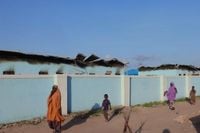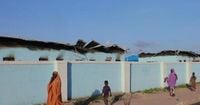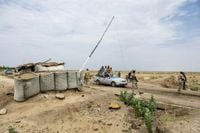In a dramatic escalation of violence in northeastern Nigeria, the country’s military announced on Thursday, October 23, 2025, that it had killed more than 50 armed insurgents after a series of coordinated attacks on army bases. According to statements from the Nigerian military and reports from outlets like AFP and the Associated Press, the attacks unfolded in the early morning hours across several towns—Dikwa, Mafa, and Gajibo in Borno state, as well as Katarko in neighboring Yobe state.
The insurgents, believed by intelligence sources to be members of the Islamic State West Africa Province (ISWAP), a splinter faction of Boko Haram, launched their assault using a combination of drones and rocket-propelled grenades (RPGs). This tactic marks a worrying evolution in the militants’ capabilities. As Lieutenant Colonel Sani Uba, spokesperson for the Nigerian Army, explained in an official statement, “The combined ground and air efforts resulted in the neutralisation of over 50 terrorists across all the locations.”
Ground troops, backed by fighter jets, responded swiftly as the militants attempted to breach army defenses. The Nigerian military’s counterattack was described as a joint operation involving both ground and aerial components. The army’s pursuit of the attackers did not end with the initial confrontation; as of Thursday, operations were still ongoing to track down “over 70 of the wounded” insurgents, according to Uba. The military seized dozens of Kalashnikov rifles, machine guns, and RPGs left behind by the militants.
The fighting was fierce and costly on both sides. Several Nigerian soldiers were wounded, though the military did not disclose exact figures. The insurgents’ use of drones—often commercially available models modified to drop explosives—inflicted significant damage. “Some vehicles and buildings were also gutted by fire from the terrorists’ armed drones and RPG fire during the battle, especially in Mafa and Dikwa, where a part of the defences were momentarily breached,” Uba stated.
Images shared by the Nigerian Army on social media depicted soldiers standing over the bodies of slain jihadist fighters and their confiscated weapons at one of the targeted bases. The aftermath of the attacks was visible on the ground as well. In Mafa, residents provided videos and photos to AFP showing the charred remains of several trucks set ablaze by the militants. According to locals, these trucks were largely laden with cement destined for Chad, and their drivers had parked overnight, wary of militant ambushes on the highway.
The audacity and coordination of the attacks underscore the enduring threat posed by ISWAP. Security reports prepared for the United Nations and cited by AFP revealed that militants who attacked the bases in Gajibo and Dikwa entered Nigeria from neighboring Cameroon. Despite suffering heavy losses, including the deaths of five commanders, the insurgents managed to raid and loot the base in Mafa after temporarily forcing troops to withdraw.
The conflict in northeastern Nigeria is now in its sixteenth year. Boko Haram, the original insurgent group, began its campaign in 2009 with the aim of imposing a radical version of Islamic law and rejecting Western education. The group’s violence has since spilled over into neighboring countries, including Cameroon, Niger, and Chad, prompting the formation of a regional military coalition to combat the threat. After the death of longtime Boko Haram leader Abubakar Shekau in 2021, the group split into two main factions: the original Boko Haram and ISWAP, the latter now notorious for targeting military positions with increasing sophistication.
The human cost of this protracted conflict is staggering. According to United Nations estimates cited by the Associated Press, more than 35,000 civilians have died, with some sources putting the total death toll above 40,000. The violence has displaced over two million people, turning vast swathes of northeastern Nigeria into a humanitarian crisis zone. Just last month, Boko Haram militants killed at least 60 people in a nighttime raid on Darul Jamal, a village in the region.
The Nigerian military has adapted its strategy over time in an effort to stem the tide of insurgent attacks. Since 2019, soldiers have abandoned some smaller, more vulnerable outposts in favor of larger, heavily fortified garrisons known as “super camps.” The idea was to better withstand militant assaults, but critics argue that this approach has left rural communities more exposed, allowing insurgents greater freedom to operate and target travelers for kidnapping or ambush. “Although violence has waned since its peak a decade ago, researchers have warned of an uptick in jihadist attacks this year,” noted AFP.
Earlier in October 2025, the region saw more bloodshed when at least 14 Nigerian soldiers were killed in two separate attacks in Borno state—one at an army base, the other during an ambush on a military convoy. These incidents highlight the persistent danger faced by Nigerian forces and the resilience of the insurgent groups they are fighting.
International support has played a role in Nigeria’s ongoing struggle for security. Recently, the United States approved a potential $346 million weapons sale to Nigeria, aimed at bolstering the country’s ability to respond to the evolving threat. The conflict’s regional dimension also means that cooperation with neighboring countries remains essential, as militants frequently cross porous borders to launch attacks and evade capture.
The use of drones by insurgents represents a particularly troubling development. Commercially available drones, when modified to drop bombs or grenades, can bypass traditional security measures and inflict significant damage on both military targets and civilian infrastructure. This tactic, once the preserve of state actors, is now firmly in the hands of non-state groups like ISWAP, raising the stakes for Nigeria’s security forces and their allies.
For the people of northeastern Nigeria, the violence has become a grim part of daily life. The destruction of trucks and goods—often the lifeblood of local economies—adds another layer of hardship for communities already reeling from displacement and insecurity. The drivers who park overnight on highways, fearful of militant attacks, are a stark reminder of how deeply the conflict has penetrated ordinary existence.
As ground and aerial pursuits continue to hunt down the wounded insurgents, the Nigerian military’s latest victory is tempered by the knowledge that the fight is far from over. The resilience and adaptability of groups like ISWAP ensure that the region remains volatile, with the threat of further attacks ever-present. The struggle for stability in northeastern Nigeria, it seems, will require not just military might, but also sustained regional cooperation, international support, and a determined effort to address the root causes of extremism.
In the shadow of these ongoing battles, the people of northeastern Nigeria press on, hoping for a day when the guns will finally fall silent and life can return to something resembling normalcy.


